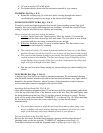PRECAUTIONS IN SHOOTING
-The optical design for Di takes into consideration the various features of digital single
reflex cameras. However, due to the configuration of the digital single reflex cameras,
even when autofocus accuracy is within specifications, the focal point may be a little
forward or behind the optimum point when shooting with autofocus under some
conditions.
-The Tamron lenses described here employ an internal focusing (IF) system. Because of
the characteristics of this optical design, the angles of view at distances other than infinity
are wider than that of the lenses applying an ordinary focusing system.
-When the built-in flash on the camera is used, adverse photographic phenomena such as
corner illumination fall-off or vignetting at the bottom part of the image may be
observed, especially in wide angle ranges. This is due to the inherent limitation of the
coverage of the built-in flash, and/or the relative position of the flash to the edge of the
lens barrel which causes shadows on the image. It is strongly recommended to use a
suitable separate flash unit provided by the camera manufacturer for all flash
photography.
-For further details, please read the "built-in flash" article on the instruction manual of
your camera.
-Certain camera models may indicate the maximum and minimum aperture values of the
lens in approximate numbers. This is inherent to the design of the camera and not an
indication of an error.
-Please be aware that there is no infrared index line on an models listed in this owner's
manual, and therefore, practically, no black-and-white infrared film can be used with
these lenses.
-When using a special filter such as a PL filter, use low profile filters. The thick rim of a
normal filter may cause vignetting.
TO ENSURE LONG-TERM SATISFACTION
-Avoid touching the glass element surface. Use a photographic lens cloth or blower to
remove dust from the lens element surface. When not using the lens, always place a lens
cap on it for protection.
-Use a lens cleaning tissue or lint cloth with a drop of cleaning solution to remove
fingerprints or dirt on the glass lens surface with a rotary motion from the center to the
edge.
- Use a silicon cloth to clean your lens barrel only.
-Mildew is an enemy of your lens. Clean the lens after shooting near water or in any
humid place. Store your lens in a clean, cool, dry place. When storing the lens in a lens
case, store it with commercially available drying agents such as silicagel, and change the
agent occasionally. If you find mildew on your lens, consult an authorized repair shop or
nearby photographic store.
-Do not touch the lens-camera interface contacts since dust, dirt and/or stains may cause a
contact failure between the lens and camera.
-When using your equipment [camera(s) and lens(es)] in an environment where the
temperature changes from one extreme to the other, make sure to put your equipment
temporarily in a case or plastic bag for a length of time in order for the equipment to go
through a gradual temperature shift. This will reduce potential equipment trouble.








